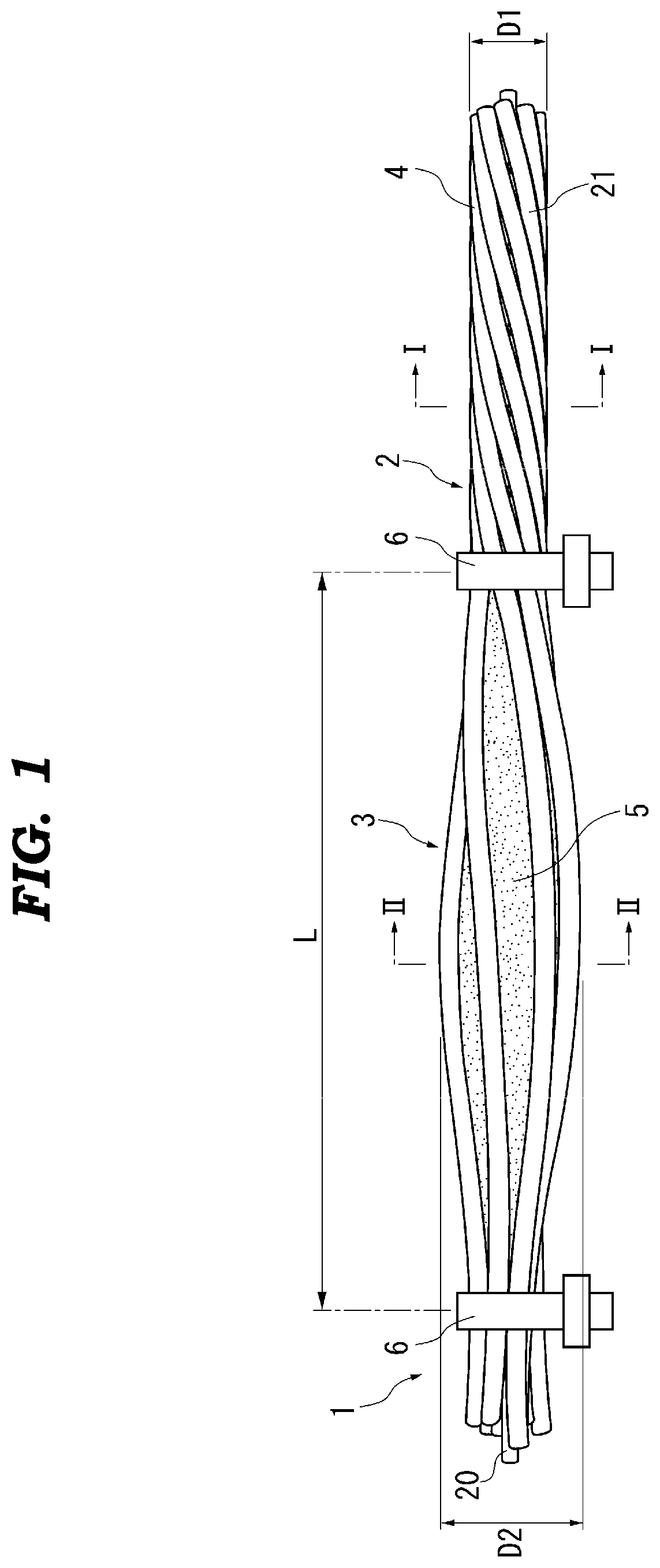Anchorage of continuous fiber-reinforced polymer strands
a technology of reinforced polymer strands and anchoring, which is applied in the direction of building components, structural elements, building material handling, etc., can solve the problems of high processing cost, increased processing time, and inability to meet the requirements of bending process from straight shaped cfrps, so as to reduce manufacturing costs, increase transport efficiency, and stable anchoring performance
- Summary
- Abstract
- Description
- Claims
- Application Information
AI Technical Summary
Benefits of technology
Problems solved by technology
Method used
Image
Examples
verification experiments
[0061]Next, using Table 1, Table 2, and FIG. 7, verification experiments that have been performed to confirm an anchoring effect of the present invention will be described.
experiment 1
Pull-Out Experiment 1
[0062]First, a pull-out experiment 1 in which CFRP strands are pulled out from test pieces in which the CFRP strands composed of the carbon fibers similar to the above-described anchorage 1 are anchored in concrete was executed. In this pull-out experiment 1, CFRP strands (guaranteed breaking load Pg=270 kN) with the diameter D1=15.2 mm formed of seven element wires similar to the above-described anchorage 1 was used. The maximum diameters D2 of the untwisted diameter-expanded portions 3 were 1.2 to 2.6 times the diameter D1 of the general portions 4. The test pieces have a concrete portion whose cross-sectional dimension was 500 mm×500 mm and whose length was 470 mm. Relatively high strength concrete with compressive strength of 56 N / mm2 was used. For a portion of the CFRP strands other than the untwisted diameter-expanded portion 3, the bond stress was cut with a vinyl tape+application of grease. Grout cement mortar with compressive strength of 70 N / mm2 was us...
experiment 2
Pull-Out Experiment 2
[0067]In a pull-out experiment 2, the comparisons of pull-out experiments were performed for a case where the curable material 5 (polymer cement mortar, compressive strength=74 N / mm2) filled into the untwisted diameter-expanded portion 3 was filled and a case where the curable material 5 was not filled, and the influences on the anchoring effect of the curable materials 5 were examined. The used CFRP strands have a diameter D1=15.2 mm (guaranteed breaking load Pg=270 kN). The concrete test piece has a cross-sectional dimension of 150 mm×150 mm, is provided with a 20 mm bonding cut, and has concrete compressive strength of 71 N / mm2.
[0068]The maximum diameter D2 of the untwisted diameter-expanded portion 3 was 1.5 times the diameter D1 of the general portion 4. For CFRP strands of test pieces, three types of test pieces with lengths L of the untwisted diameter-expanded portions 3 of ten times (L=152 mm), fifteen times (L=228 mm), and twenty times (L=304 mm) the di...
PUM
| Property | Measurement | Unit |
|---|---|---|
| diameter | aaaaa | aaaaa |
| diameter | aaaaa | aaaaa |
| tensile strength | aaaaa | aaaaa |
Abstract
Description
Claims
Application Information
 Login to View More
Login to View More - R&D
- Intellectual Property
- Life Sciences
- Materials
- Tech Scout
- Unparalleled Data Quality
- Higher Quality Content
- 60% Fewer Hallucinations
Browse by: Latest US Patents, China's latest patents, Technical Efficacy Thesaurus, Application Domain, Technology Topic, Popular Technical Reports.
© 2025 PatSnap. All rights reserved.Legal|Privacy policy|Modern Slavery Act Transparency Statement|Sitemap|About US| Contact US: help@patsnap.com



